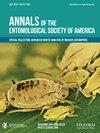The First Biological Portrait of Stalk-Eyed Fruit Flies: Life History, Reproductive Biology and Host Use Patterns in Pelmatops spp. (Diptera:Tephritidae)
IF 1.8
3区 农林科学
Q1 ENTOMOLOGY
引用次数: 2
Abstract
Abstract The stalk-eyed fruit flies, with their eyes borne at the ends of long stalks, are distinctly different from all other members of the family Tephritidae (Diptera). They resemble stalk-eyed flies (Diptera, Diopsidae) but they are much larger and their antennae are located in the middle of the head instead of on the eye stalks. The stalk-eyed fruit flies are represented by two genera (Pelmatops Enderlein and Pseudopelmatops Shiraki) mainly found in the Oriental tropics and subtropics, but their basic biology remains poorly documented. Here, we describe the life history, reproductive biology, and host use patterns of Pelmatops spp. (mainly P. ichneumoneus (Westwood)). These flies used two local brambles, Rubus setchuenensis and R. multibracteatus (Rosales, Rosaceae), as hosts, with females laying eggs below the epidermal tissue.The larvae bore into the stem, where they feed, eventually dropping to the ground to pupate in the soil. We describe the pupal morphology and eclosion, including the elongation of their eye stalks, feeding, mating, and agonistic behavior in adults. We observed mating between female P. ichneumoneus and male P. tangliangi and tentatively suggest that the two species could be conspecific. Our work presents the first detailed report on the biology of stalk-eyed fruit flies and it lays a significant foundation for future studies on the ecology and evolution of this group.茎眼果蝇的第一幅生物图谱:Pelmatops spp.的生活史、繁殖生物学和寄主利用模式(直翅目:地蝇科)
摘要茎眼果蝇的眼睛长在茎的末端,与地蝇科的所有其他成员有明显的不同。它们类似于眼蝇(直翅目,直翅目),但它们要大得多,它们的触角位于头部中部,而不是眼柄上。柄眼果蝇有两个属(Pelmatops Enderlein和Pseudopelmatops Shiraki),主要分布在东方热带和亚热带,但它们的基本生物学记录很少。在这里,我们描述了Pelmatops spp.(主要是P.ichneumoneus(Westwood))的生活史、生殖生物学和宿主使用模式。这些苍蝇使用两种当地的荆棘,悬钩子(Rubus setchuenensis)和R.multibracteatus(Rosales,Rosaceae)作为宿主,雌性在表皮组织下产卵。幼虫钻入茎中,在那里觅食,最终落到地上,在土壤中化蛹。我们描述了蛹的形态和羽化,包括它们眼柄的伸长、进食、交配和成虫的痛苦行为。我们观察到雌性伊氏肺吸虫和雄性唐氏肺吸虫之间的交配,并初步认为这两个物种可能是同种的。我们的工作首次详细报道了茎眼果蝇的生物学,为未来研究该类群的生态学和进化奠定了重要基础。
本文章由计算机程序翻译,如有差异,请以英文原文为准。
求助全文
约1分钟内获得全文
求助全文
来源期刊
CiteScore
4.90
自引率
0.00%
发文量
25
审稿时长
6-12 weeks
期刊介绍:
The Annals of the Entomological Society of America exists to stimulate interdisciplinary dialogue across the entomological disciplines and to advance cooperative interaction among diverse groups of entomologists. It seeks to attract and publish cutting-edge research, reviews, collections of articles on a common topic of broad interest, and discussion of topics with national or international importance. We especially welcome articles covering developing areas of research, controversial issues or debate, and topics of importance to society. Manuscripts that are primarily reports of new species, methodology, pest management, or the biology of single species generally will be referred to other journals of the ESA. The most important criteria for acceptance are quality of work and breadth of interest to the readership.

 求助内容:
求助内容: 应助结果提醒方式:
应助结果提醒方式:


